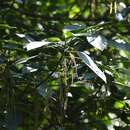ar
الأسماء في صفحات التنقل


Myriocarpa is a genus woody plant which ranges in size from shrubs to small trees and is endemic to Central and South America. Within the Urticaceae, Myriocarpa is characterized by long pendulous string-like female inflorescences of apparently naked flowers and stems which release a watery latex when cut. Estimates for the diversity of the genus range from five to eighteen species.[1][2] Research for Flora Mesoamericana indicates that there are probably fifteen to twenty species.
The genus was described by George Bentham in 1846[3] based on Colombian specimens of Myriocarpa stipitata collected by Mss. Barclay. Weddell placed Myriocarpa in the Urticaceae tribe Boehmerieae[4][5] despite its anomalous pubescence, cystolith morphology and wood anatomy. In his review of the Urticaceae,[2] Friis retained its position within the Boehmerieae, presumably because its position in any other Urticaceae tribe would be equally ambiguous. The position of Myriocarpa within the Boehmerieae is not supported by recent phylogenetic analyses of trnL-F sequence data[6] that recovered Myriocarpa within a strongly supported clade including both the Urticeae and Lecantheae tribes.
Its position within either one of these tribes however, is unresolved. Based on hair, leaf and flower morphology, Myriocarpa could equally well be placed in the Lecantheae (absence of hooked hairs) or the Urticeae (alternate leaves, pistillodes not ejecting the achene) and further research, both molecular and morphological, is warranted.
The last major revision of the genus, at which time six species were recognized, was that of Hugh Algernon Weddell.[5] Since this revision Myriocarpa has attracted little taxonomic interest outside of floristic treatments,[1][7] despite its unusual female inflorescence morphology and ambiguous position within the Urticaceae and currently a total of 24 species names have been published.[8]
Myriocarpa is a genus woody plant which ranges in size from shrubs to small trees and is endemic to Central and South America. Within the Urticaceae, Myriocarpa is characterized by long pendulous string-like female inflorescences of apparently naked flowers and stems which release a watery latex when cut. Estimates for the diversity of the genus range from five to eighteen species. Research for Flora Mesoamericana indicates that there are probably fifteen to twenty species.
The genus was described by George Bentham in 1846 based on Colombian specimens of Myriocarpa stipitata collected by Mss. Barclay. Weddell placed Myriocarpa in the Urticaceae tribe Boehmerieae despite its anomalous pubescence, cystolith morphology and wood anatomy. In his review of the Urticaceae, Friis retained its position within the Boehmerieae, presumably because its position in any other Urticaceae tribe would be equally ambiguous. The position of Myriocarpa within the Boehmerieae is not supported by recent phylogenetic analyses of trnL-F sequence data that recovered Myriocarpa within a strongly supported clade including both the Urticeae and Lecantheae tribes.
Its position within either one of these tribes however, is unresolved. Based on hair, leaf and flower morphology, Myriocarpa could equally well be placed in the Lecantheae (absence of hooked hairs) or the Urticeae (alternate leaves, pistillodes not ejecting the achene) and further research, both molecular and morphological, is warranted.
The last major revision of the genus, at which time six species were recognized, was that of Hugh Algernon Weddell. Since this revision Myriocarpa has attracted little taxonomic interest outside of floristic treatments, despite its unusual female inflorescence morphology and ambiguous position within the Urticaceae and currently a total of 24 species names have been published.
Myriocarpa es un género botánico con 24 especies de arbustos perteneciente a la familia Urticaceae. Son arbustos o pequeños árboles nativos de Sudamérica.
Son arbustos a árboles de tamaño mediano, sin tricomas urticantes; plantas dioicas o raramente monoicas. Las hojas están dispuestas de forma alterna, el margen dentado a entero, con cistolitos lineares generalmente visibles en la haz, nervadura pinnada o subtrinervia; las estípulas intrapeciolares completamente connadas, generalmente envolviendo el brote apical. Las inflorescencias generalmente unisexuales, paniculadas o espigas muy largas desde una base ramificada; las flores masculinas con perianto 4-partido; flores femeninas sin perianto pero abrazadas por 2 bractéolas pequeñas en la base, estigma oblongo a linear, densamente papiloso. El fruto es un aquenio aplanado, con bractéolas, estilo y estigma generalmente persistentes.
Myriocarpa es un género botánico con 24 especies de arbustos perteneciente a la familia Urticaceae. Son arbustos o pequeños árboles nativos de Sudamérica.
Myriocarpa é um género botânico pertencente à família Urticaceae[1].
Myriocarpa é um género botânico pertencente à família Urticaceae.
«Myriocarpa — World Flora Online». www.worldfloraonline.org. Consultado em 19 de agosto de 2020Myriocarpa là chi thực vật có hoa trong họ Tầm ma.[1]
Chi này gồm các loài:
Myriocarpa là chi thực vật có hoa trong họ Tầm ma.